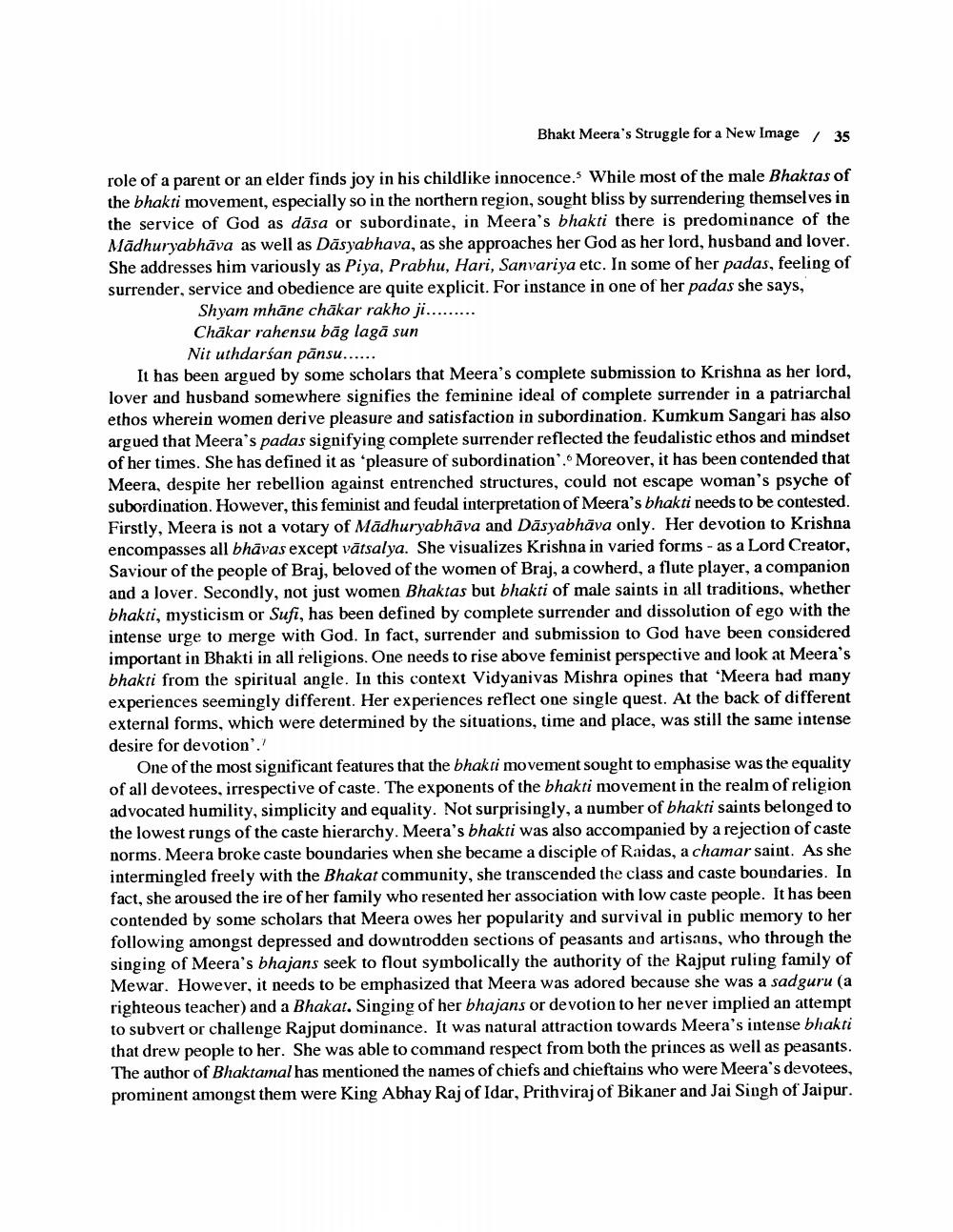________________
Bhakt Meera's Struggle for a New Image
35
role of a parent or an elder finds joy in his childlike innocence. While most of the male Bhaktas of the bhakti movement, especially so in the northern region, sought bliss by surrendering themselves in the service of God as dāsa or subordinate, in Meera's bhakti there is predominance of the Mādhuryabhāva as well as Dāsyabhava, as she approaches her God as her lord, husband and lover. She addresses him variously as Piya, Prabhu, Hari, Sanvariya etc. In some of her padas, feeling of surrender, service and obedience are quite explicit. For instance in one of her padas she says,
Shyam mhāne chākar rakho ji......... Chākar rahensu bāg lagā sun
Nit uthdarśan pansu...... It has been argued by some scholars that Meera's complete submission to Krishna as her lord, lover and husband somewhere signifies the feminine ideal of complete surrender in a patriarchal ethos wherein women derive pleasure and satisfaction in subordination. Kumkum Sangari has also argued that Meera's padas signifying complete surrender reflected the feudalistic ethos and mindset of her times. She has defined it as pleasure of subordination. Moreover, it has been contended that Meera, despite her rebellion against entrenched structures, could not escape woman's psyche of subordination. However, this feminist and feudal interpretation of Meera's bhakti needs to be contested. Firstly, Meera is not a votary of Mādhuryabhāva and Dāsyabhāva only. Her devotion to Krishna encompasses all bhāvas except vātsalya. She visualizes Krishna in varied forms - as a Lord Creator, Saviour of the people of Braj, beloved of the women of Braj, a cowherd, a flute player, a companion and a lover. Secondly, not just women Bhaktas but bhakti of male saints in all traditions, whether bhakti, mysticism or Sufi, has been defined by complete surrender and dissolution of ego with the intense urge to merge with God. In fact, surrender and submission to God have been considered important in Bhakti in all religions. One needs to rise above feminist perspective and look at Meera's bhakti from the spiritual angle. In this context Vidyanivas Mishra opines that "Meera had many experiences seemingly different. Her experiences reflect one single quest. At the back of different external forms, which were determined by the situations, time and place, was still the same intense desire for devotion'.)
One of the most significant features that the bhakti movement sought to emphasise was the equality of all devotees, irrespective of caste. The exponents of the bhakti movement in the realm of religion advocated humility, simplicity and equality. Not surprisingly, a number of bhakti saints belonged to the lowest rungs of the caste hierarchy. Meera's bhakti was also accompanied by a rejection of caste norms. Meera broke caste boundaries when she became a disciple of Raidas, a chamar saint. As she intermingled freely with the Bhakat community, she transcended the class and caste boundaries. In fact, she aroused the ire of her family who resented her association with low caste people. It has been contended by some scholars that Meera owes her popularity and survival in public memory to her following amongst depressed and downtrodden sections of peasants and artisans, who through the singing of Meera's bhajans seek to flout symbolically the authority of the Rajput ruling family of Mewar. However, it needs to be emphasized that Meera was adored because she was a sadguru (a righteous teacher) and a Bhakat. Singing of her bhajans or devotion to her never implied an attempt to subvert or challenge Rajput dominance. It was natural attraction towards Meera's intense bhakti that drew people to her. She was able to command respect from both the princes as well as peasants. The author of Bhaktamal has mentioned the names of chiefs and chieftains who were Meera's devotees, prominent amongst them were King Abhay Raj of Idar, Prithviraj of Bikaner and Jai Singh of Jaipur.




